It is no secret that Scorpio season (October 22nd – November 21st) is a time for contemplating the ever-present cycle of death and rebirth. This, I can only assume, is why many of the holidays celebrated this time of year (Halloween, el Día de los Muertos, Samhain, All Saints’ Day, etc.), regardless of the cultures where they originate, focus on the same themes. So, if you find yourself wanting to dig deep into the metaphors this season has to offer, I am pleased to present a guide for foraging two very common plants of the land in and around UMass: Burdock and Yellow Dock.
The first and most important part of any endeavor involving plants is to cultivate a sense of the right timing. As the air chills and plants begin to change into their dormant forms, we look to their roots and seeds not only for the promise of new life come spring, but also for the unique nourishment they offer us right now. If we want to find the most ideal time within this season to partake of these gifts, we can consult the moon.
This week (November 7th – 14th), the moon is waning and will eventually disappear completely – what’s called a new moon. On the 14th, since the sun is in the sign of Scorpio, so too will be the moon. See, the light that shines at night is merely the sun reflecting on the moon’s surface, so when the moon is new, it is sitting right on top of the sun.
Traditionally, in most cultures the world over, people have understood that it is smarter to work with nature than against it. This, by no coincidence, is also a guiding principle of permaculture design. Not everyone, however, considers the moon when they first think of nature, even if they know it creates ocean tides. My question for the doubtful: why should our bodies, the bodies of plants or even the soil – all majority water – be impacted any less by the moon than the vast seas?
Though it is possible to spend many lifetimes studying the intricacies of how celestial bodies effect life on Earth, all anyone really needs to begin working with the moon is the power of careful observation. Any study of cycles inherently takes time and is relative to the location where you find yourself. Therefore, it is best to learn slowly, from many sources, over the course of your entire life. So, if all these ideas are new to you, congratulations, you’ll never know boredom again!
I was first introduced to the practice of planting, harvesting, and tending by the moon when presented with a biodynamic calendar last year. Biodynamics is a comprehensive agricultural method / lifestyle based on the teachings of Rudolf Steiner. Today, I only wish to share one simple biodynamic practice as it relates to harvesting roots: digging them up in the early morning darkness of
a day when the moon is waning. See, light and heat from the sun and moon draw a plant’s nutrient-dense fluids (the source of their medicinal properties) upwards and into their stems, leaves, flowers, fruit, and seeds. Therefore, when it is coldest and darkest, roots are most robust. So, if you find yourself brave and awake enough some spooky morning this week to venture out with a headlamp and shovel, read on for detailed root harvesting (and subsequent seed scattering) instructions!
Note: I took the pictures below in the afternoon, on a day when the moon was waxing – not ideal. This, however, just goes to show that sometimes (especially when you’re in school and forced to work on the schedule of “the man” instead of the moon), you just got to do things when you have the time. Don’t let the sun, moon, stars, or anyone stop you from getting outside whenever you’re free! No practice is perfect, that’s why it’s called practice.
Step 1: Find the Right Plants
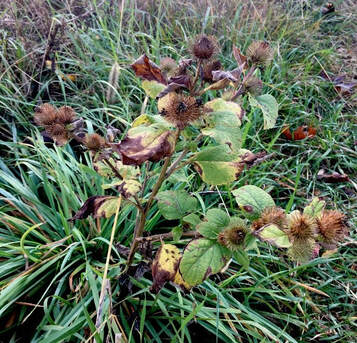
Burdock is easy to identify by its uniquely sticky seeds. These little burrs cling to anything soft, so if you find them on your shoelaces and socks – or in my case, dog leash – you’ll know you’re in the right place.
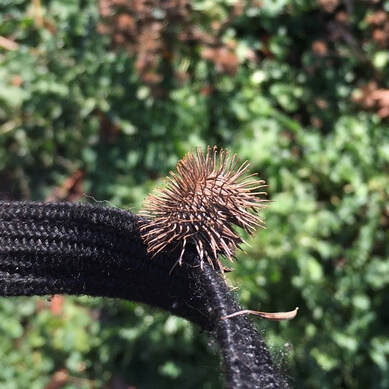
Once you’ve made a positive identification based on these little guys, look around for a plant with the same leaves and overall shape, but no seed stock.
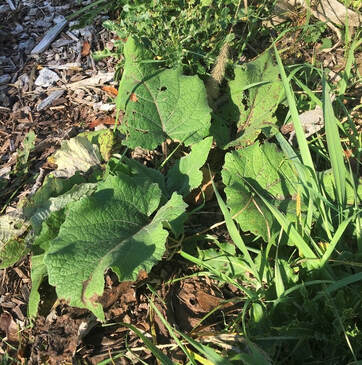
Being a biennial, Burdock only makes flowers and seeds in its second year of growth. By that time, the root is no longer good to eat or use for medicine, so you’ll want to leave it in the ground. If you really want to make sure you know what you’re looking for, burn this image of a Burdock leaf into your brain:
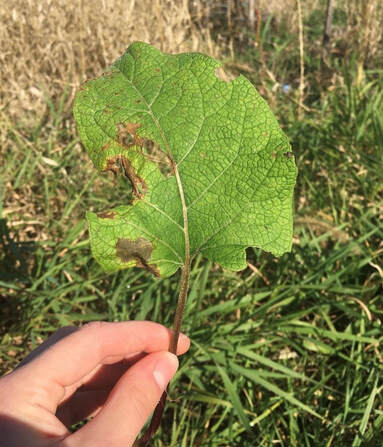
Yellow Dock is another plant easily identifiable by its seeds. Unlike Burdock, Yellow Dock is a perennial. So, if you find a seed stock, you can dig up its root without worry.
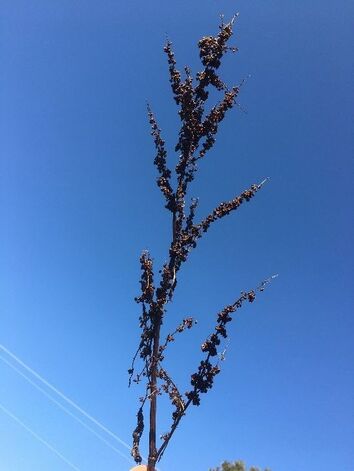
Yellow Dock also goes by the name curly dock and for good reason – its leaves curl inwards around their edges.
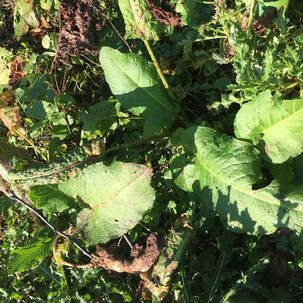
Here is a closer look at the curliest leaf this particular plant had to offer. In this image you might also be able to see that the leaf is speckled – just another detail to spot for verification in the field.
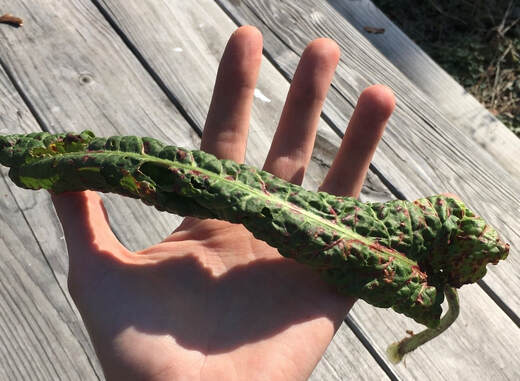
Step 2: Ask
Before taking any living being from its home, it’s best to ask permission. I’ll be exploring the logic, morals, and history of this practice in my next post, so stay tuned if you’re interested. For now, though, just try to remember when you’re interacting with the more-than-human world that the creatures you are harvesting deserve respect, then ask yourself how your actions can reflect this knowledge. Even a simple pause, breath, and “thank you” spoken inside your head is better than nothing. See, if you slow your process down, you’ll be much less likely to damage the overall population of the individual plant you’re harvesting. Taking the time to make sure you’ve selected individuals in areas where their kind grows in abundance guarantees that the present supply of food and medicine will be readily available whenever you, or anyone else, need it in the future.
Step 3: Dig
To dig roots, all you really need is a normal shovel, some strength, and a desire to be covered in dirt. But if you find yourself with access to specialized tools like the ones pictured below, give them a try. They’ll make it easier to dig deep around the taproot without risking breakage.
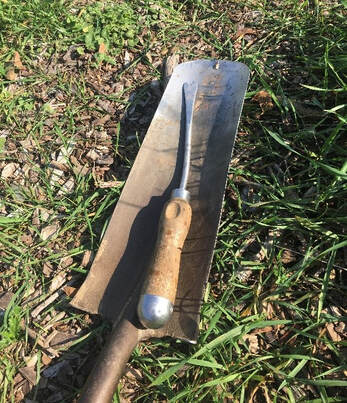
Begin by loosening the earth around a single plant, then carefully excavate until you’re deep enough to pull the long root up in full. If you don’t get it all, though, don’t worry! This gives the plant a chance to regenerate, which is good in a different way
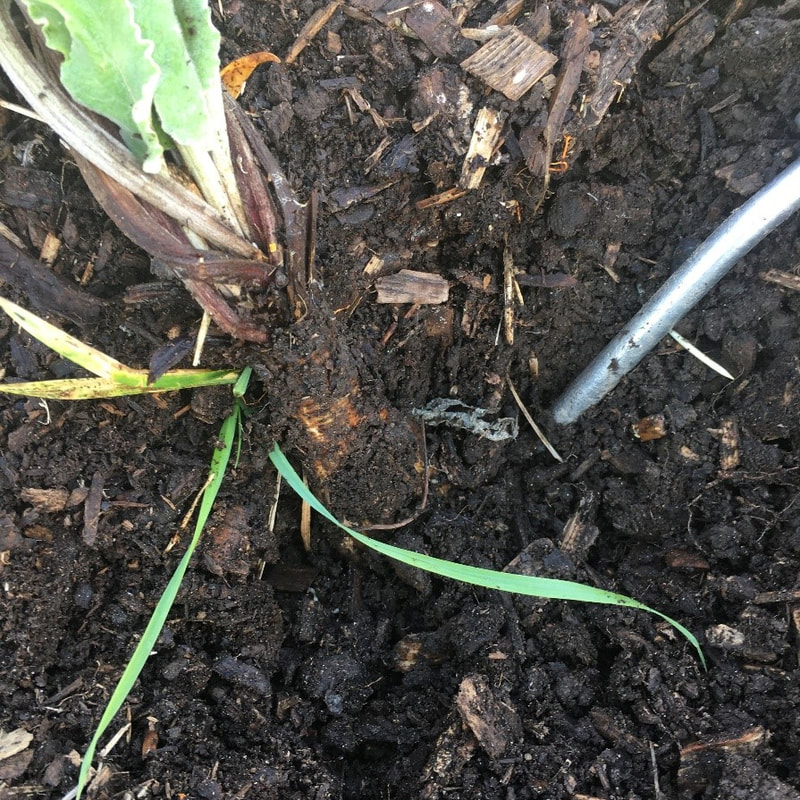
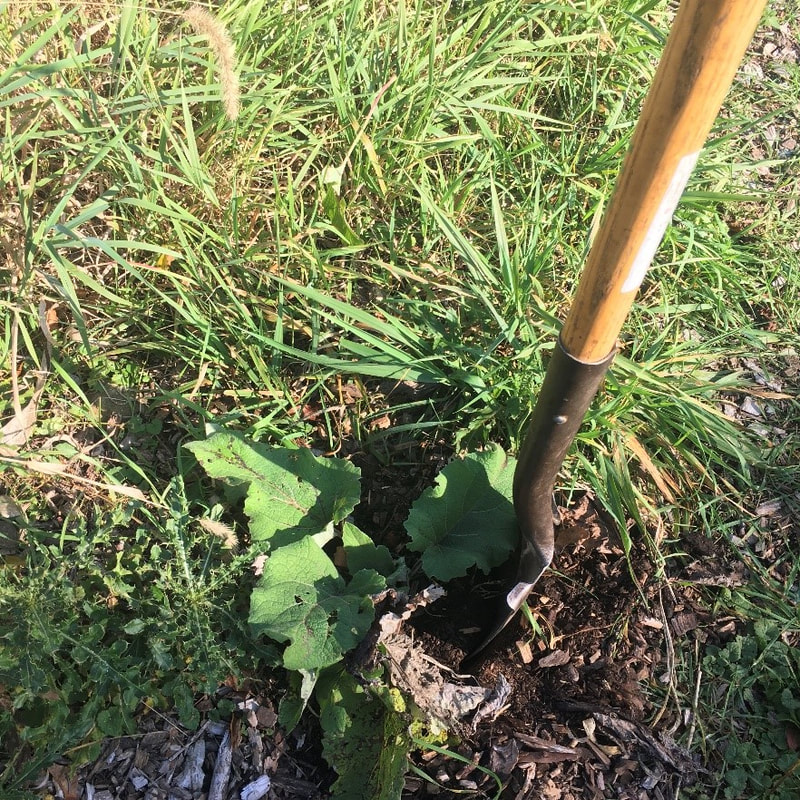
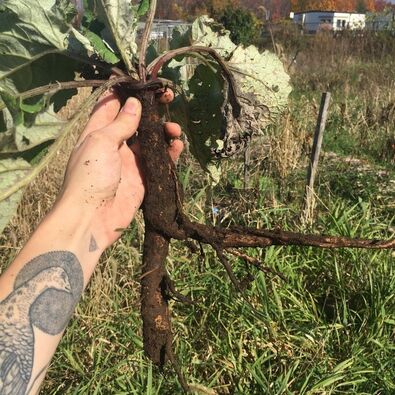
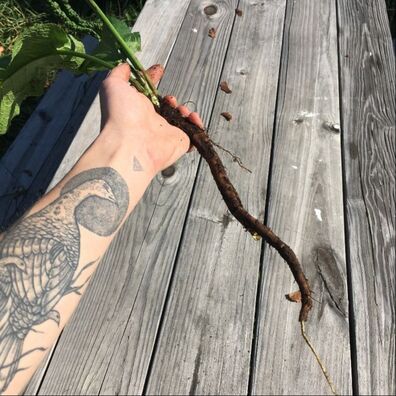
Step 4: Scatter Seeds
Another way to ensure a sustainable harvest is to scatter the seeds of the plant you’ve just dug up. When it comes to Burdock, since its seeds are sticky, you’ll be doing this without thought. When it comes to the Yellow Dock, however, seed scattering takes a conscious choice – particularly because the seeds themselves can be made into very tasty treats! After you’ve given the land its fair share of the seed bounty, run the rest through a coffee grinder or smash them with a mortar and pestle. The processed seeds can then be used in any recipe that calls for gluten free flour. To make a medicinal coffee-adjacent beverage, toast them in the oven at 350 degrees for 5 minutes before grinding, then brew a cup any way you’d usually make coffee. Drink it straight or add sweetener and enjoy! My favorite addition is maple syrup, yummmm…
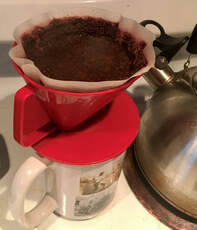
Step 5: Process your Roots
The final step in any harvest that’s not immediately edible is to preserve it. If you don’t have the ability to wash your roots right away, remove the foliage from their tops and place them in a brown paper bag to keep them fresh. When you have the means, wash your roots with water and a scrub brush. Once they’re clean, there are nearly infinite options for consumption – a quick internet search will present you with recipes galore, as well as resources presenting facts including the medicinal properties of each root. The most immediate way to enjoy Burdock is to eat it for breakfast. Broil it in the oven like any other root vegetable or add to soups or stir-fries (don’t try this with Yellow Dock, though, its root is very bitter). Any way you take them in, both will greatly support your liver’s ability to flush toxins from your body among many other benefits.
Happy Digging!
